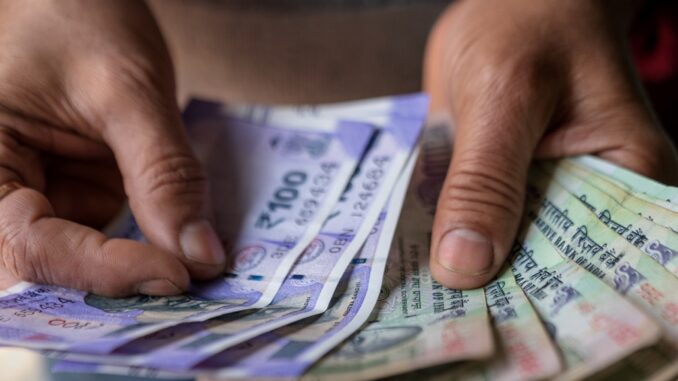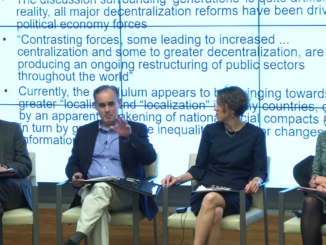
Improving subnational resource mobilization – or the process by which subnational governments raise and spend funds on behalf of their constituents – is critical to ensuring sustainable progress towards development goals. In many places, reforms and investments may be needed at the subnational level to ensure governments have the resources and accountability to effectively provide necessary public services, support transparent governance, and nurture a conducive economic environment for private sector growth.
In most developing countries, including those in which USAID works, subnational government revenue is limited: it is about a fifth of general government revenue and a fraction of national GDP (ranging from 3.8 percent in low-income countries to 7 percent in upper middle-income countries). About half of subnational revenue comes from intergovernmental transfers and grants with about a third from taxes and the remainder from fees or other sources.
Subnational governments, including urban local governments, and authorities in cities, city-regions, and peri-urban areas, face several challenges in mobilizing resources, especially raising own-source revenue. Improving subnational domestic resource mobilization (DRM) can be tricky. It requires overcoming political, legal, and administrative challenges and managing a diverse array of stakeholders. This hampers their ability to deliver basic public services and create an enabling environment for the private sector and undermines the social contract between government and citizenry.
USAID contracting the Urban Institute to explore this issue further. Through a review of literature, analysis, and interviews with subject matter experts, the resulting report by Matthew Eldridge and James Ladi Williams offers several takeaways on the challenges and opportunities for improving the mobilization and management of subnational resources:
- Improving own-source revenue represents an important opportunity for subnational governments to generate needed resources and build trust with citizens. Own-source revenue is especially important to funding and improving service delivery. There are many, well-established ways to generate own-source revenue, including variants of user fees and property taxes. The relative merits of these revenue streams – including their potential to raise revenue, complexity and costs of managing, equity considerations, and potential distortionary effects – must be carefully weighed by local officials and their partners.
- Strengthening subnational resource mobilization has the potential to yield important governance dividends. Improvement in the way subnational governments mobilize resources does not only increase their resource envelopes. It also has the potential to improve transparency, strengthen the business environment, and enhance public accountability. Technical solutions, such as digitizing revenue collection or consolidating and rationalizing tax instruments, can address common administrative challenges and at the same time improve transparency and predictability in revenue collection. Tailoring these solutions to local realities, accounting for incentives and political economy dynamics, as well as sequencing and messaging reforms to build public support, can help address political challenges as well.
- Resource mobilization is more likely to gain traction if it is situated within larger conversations on subnational public financial management, including expenditure management and accountability for budgetary decisions. Investments in the broader public financial management (PFM) system, if they place the subnational government on stronger fiscal footing, are critical to ensuring improved resource mobilization is sustainable and translatable into improved outcomes. A key enabling or constraining factor is the degree of subnational fiscal autonomy, particularly whether subnational governments have authority to raise sufficient revenue to meet their expenditure responsibilities (obligations and responsibilities to citizens).
- Intergovernmental transfers are, and are likely to remain, the most significant revenue stream for most subnational governments. This reality makes sense given that own-source revenues often fall short of what subnational governments need to meet their expenditure responsibilities. Although service delivery responsibilities are often decentralized, central governments generally retain control over the revenue instruments that generate the most resources and are most efficiently administered at the central level (e.g., Value-Added-Tax, personal and corporate income tax, customs). Although transfers may weaken incentives of subnational authorities to increase own-source revenue, evidence suggests that, if well structured, they can promote equity, strengthen local administrative and financial management capacity, and advance progress towards development goals.
- Donors can best support these efforts by working with local actors to ensure a thorough understanding of the technical and political economy issues underlying the existing DRM context. Equipped with such a grounding, and taking a flexible, iterative approach, donors can support reforms by adapting international expertise to local opportunities and needs, aiming for “best fit” solutions rather than an unrealistic, context-free, international “best practice.”
USAID can support improved subnational DRM in several ways:
- Convene stakeholders to identify challenges and build coalitions for reform.
- Tap international best practice to inform locally appropriate policy advice, programming, and technical assistance.
- Lend visible support to local leaders who have made clear, effective revenue improvements, and use these as peer learning opportunities.
The authors offer the following recommendations to strengthen DRM programming:
- Ground strategies in the realities of each country, subnational context, and behavioral norms. Any strategy to improve a subnational revenue system should be based on detailed analysis of incentives for national and local stakeholders and the existing policy and legal framework. Accordingly, subnational reform efforts should focus on areas where there is sufficient local autonomy to act independently.
- Adopt a flexible, iterative approach based on experimentation, refinement, and scale-up. Some donor programs prescribe an exact approach, which is incompatible with the messy and gradual nature of subnational DRM reform. Future programs need to depart from this trend; this can be done by implementing pilots that enable continuous learning and help determine whether the program works, and if it should be scaled as-is, scaled with modifications, or shelved.
- Increase support for subnational DRM by linking with broader programs and funding on decentralization, local governance, urban governance, and public financial management. The close, mutually reinforcing relationship between improved, transparent local governance and stronger subnational resource mobilization presents particularly good opportunities for collaboration. Consequently, donors should identify opportunities for aligning DRM objectives with existing or planned programs nominally focused on other, adjacent issues, including decentralization, governance, and PFM.
- Adopt a realistic and sustainable but ambitious performance measurement framework. In addition to tracking revenue performance, subnational DRM programming should adopt nuanced performance measurement indicators that shed light on underlying factors that shape subnational revenue outcomes.
- Avoid a narrow focus on increasing revenues. Stakeholders need to be mindful of the unintended consequences that can result from designing programs around the sole goal of achieving higher revenue targets. Such an approach can lead to harmful outcomes such as incentivizing the increased use of regressive tax policies or the adoption of enforcement tactics that infringe on taxpayers’ rights.
- Ensure the appropriate leadership of key local and national stakeholders in the design and implementation of subnational DRM reforms. The success of DRM reforms depends on understanding the incentives of key local stakeholders and ensuring they are engaging in the reform process. Ensuring engagement and leadership of key stakeholders (including, individual citizens and civil society groups, elected officials, and private sector actors) in designing and implementing subnational DRM programming is critical to success.
Improving subnational resource mobilization will require an adaptive approach, which builds on international and local evidence, and adapts to changing needs, realities, and opportunities. By leveraging its access to expertise, resources, and innovations, USAID has a significant opportunity to support locally led efforts to reform and improve subnational DRM and broader subnational governance and PFM systems.
Read the full report:
Matthew Eldridge and James Ladi Williams, 2021. Improving Subnational Domestic Resource Mobilization: A Review of Issues and Opportunities for Strategic Donor Support. Washington: Urban Institute.



